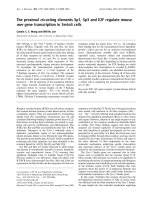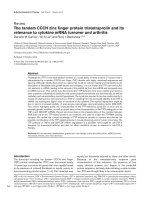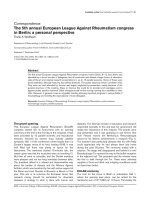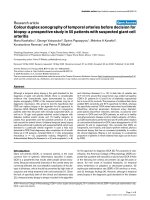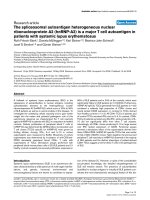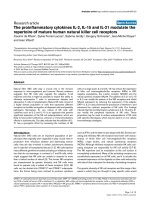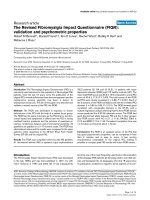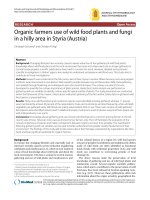Báo cáo y học: "The paediatric flat foot proforma (p-FFP): improved and abridged following a reproducibility study" pptx
Bạn đang xem bản rút gọn của tài liệu. Xem và tải ngay bản đầy đủ của tài liệu tại đây (1.24 MB, 8 trang )
BioMed Central
Page 1 of 8
(page number not for citation purposes)
Journal of Foot and Ankle Research
Open Access
Research
The paediatric flat foot proforma (p-FFP): improved and abridged
following a reproducibility study
Angela Margaret Evans*
1
, Hollie Nicholson
2
and Noami Zakarias
3
Address:
1
School of Health Science, Division of Health Science, University of South Australia, City, East Campus, North Terrace, Adelaide 5000,
South Australia, Australia,
2
Country Health SA: Yorke and Lower North Health Service, Clare, South Australia, Australia and
3
Port Pirie Regional
Health Service, Country Health SA, Port Pirie, South Australia, Australia
Email: Angela Margaret Evans* - ; Hollie Nicholson - ;
Noami Zakarias -
* Corresponding author
Abstract
Background: Concern about a child's flat foot posture is a common reason for frequent clinical
consultations for an array of health care and medical professionals. The recently developed
paediatric flatfoot clinical-care pathway (FFP) has provided an evidence based approach to diagnosis
and management. The intra and inter-rater/measurer reliability of the FFP has been investigated in
this study.
Methods: From a study population of 140 children aged seven to 10 years, a sample with flat feet
was identified by screening with the Foot posture index (FPI-6). Subjects who scored ≥ 6 on the
FPI-6 for both feet became the study's flat foot sample. A same subject, repeated measure research
design was used for this study which examined the reliability of the FFP in 31 children aged seven
to 10 years, as rated by three examiners.
Results: Approximately half of the items of the FFP showed less-than-desirable inter-rater
reliability, arbitrarily set at the conventional 0.7 level (intra-class correlations). Removal of the
unreliable items has produced a shorter; more relevant instrument designated the paediatric flat
foot proforma (p-FFP).
Conclusion: The p-FFP is a reliable instrument for the assessment and resulting treatment actions
for children with flat feet. Findings indicate that the simplified p-FFP is a reproducible instrument
for the clinical assessment of flat foot in mid-childhood.
Background
The significance of "flat feet" continues to debated within
the general community, medical and allied health fields,
as it has for decades [1-12]. Although flat foot in child-
hood is a common diagnosis and well established clinical
term, there is a lack of a reliable and reproducible tool for
the assessment of this condition.
The paediatric flat foot is a controversial topic. Whilst
many reports relating to flat feet/pes planus/pes valgus
have occupied the medical literature[4,6-8,10,11,13-20],
there remains a paucity of well-founded, scientific knowl-
edge about this common condition. A definitive defini-
tion is lacking and children's flat feet continue to be
diagnosed by a plethora of methods, from observation to
Published: 19 August 2009
Journal of Foot and Ankle Research 2009, 2:25 doi:10.1186/1757-1146-2-25
Received: 16 April 2009
Accepted: 19 August 2009
This article is available from: />© 2009 Evans et al; licensee BioMed Central Ltd.
This is an Open Access article distributed under the terms of the Creative Commons Attribution License ( />),
which permits unrestricted use, distribution, and reproduction in any medium, provided the original work is properly cited.
Journal of Foot and Ankle Research 2009, 2:25 />Page 2 of 8
(page number not for citation purposes)
clinical measurements and imaging, which are largely
unsubstantiated in terms of the reliability and validity of
the same. Flat feet, as a postural morphology, have long
been associated with pain and disability (eg an exclusion
from military service in both World Wars) and thus are
often a concern to parents from a preventative perspective
of their children's health and mobility.
The reported prevalence of paediatric flat foot varies in the
literature and ranges from approximately 3 – 15%
[1,5,21]. Views of treatment are contentious [4,6,22] and
there is little longitudinal data to provide evidence of the
efficacy of different regimen [23-25].
Clinicians often disagree about the management of flat-
feet [26,27], partly because there is no standard approach
to assessment or classification of flat foot sub types (eg
rigid, flexible, symptomatic, developmental). The flat foot
clinical pathway or proforma (FFP) developed in previous
work [28], offers an evidence based clinical tool for the
evaluation of this common childhood condition (Figure
1).
The FFP offers a structured checklist approach to signifi-
cant clinical findings viz. arch shape (weight bearing com-
pared to non-weight bearing), range of motion (reduced,
increased or asymmetry), tender areas (joint location and
presentation eg swelling), gait (limp, asymmetry, or
altered angle of gait; examined shod and barefoot), and
diagnostic studies (as available, required).
The focus of the FFP is centred on an accurate diagnosis of
the suggested sub-types of paediatric flat foot (flexible,
rigid, skewfoot, other). For the purposes of this study the
FFP observations/assessments items were collected in cat-
egorical form eg medial longitudinal arch: ok/reduced,
heel inversion with tip toe: yes/no, tibial, knee positions:
medial/straight/lateral. Clinical measures were collected
The paediatric flatfoot clinical-care pathway (FFP), as used in this reliability studyFigure 1
The paediatric flatfoot clinical-care pathway (FFP), as used in this reliability study.
Journal of Foot and Ankle Research 2009, 2:25 />Page 3 of 8
(page number not for citation purposes)
in the units of measure (degrees, millimetres) or as scaled
observations for FPI-6 criteria. The FPI-6 was used as
described elsewhere [29] to assess all subjects overall foot
posture. The FPI-6 consists of six separate scaled observa-
tions (-2 to +2) which are then summed to give a total
score/foot. The FPI-6 total scores range from -12 (highly
supinated) to +12 (highly pronated) and provides a scaled
rating of static foot posture.
The present study was undertaken to assess the reproduc-
ibility of the FFP, when used by the same observer and
between different observers evaluating the same subject.
Ethical approval was obtained from the Human Research
and Ethics committee at the University of South Australia.
Two primary schools in Port Pirie were approached and
consented to being involved in the study. Consent forms
were returned from the parents of 140 children, aged
between seven and 10 years.
Methods
All 140 paediatric subjects were initially assessed by the
one examiner (AE) using the Foot Posture Index (FPI-6) to
establish designated flatfoot status [29-31]. Of these, 31
subjects returned an FPI-6 score of ≥ = 6 for both feet, indi-
cating bilateral flat foot [29] and these subjects were
selected for the flatfoot proforma reproducibility study.
All measures were recorded against each child's allocated
identity (ID) code. Coloured paper (eg pink, green, blue)
to designate each investigator, were used for the FFP
charts, with 'am' on the first examination session sheets
and 'pm' on the repeated examination sheets. All meas-
ures were performed with children dressed but with shoes
and socks removed.
The reliability study followed standard protocol as a same
subject, repeated measures investigation by three examin-
ers. Each child removed their shoes and socks and stood
on a low table approximately 0.5 m in height. The child
was asked to look straight ahead (out of a window) whilst
their feet were examined. Each of the investigators
observed the child's feet and recorded their findings via
the FFP. Each child's gait was also briefly observed by each
investigator. The total foot examination time took approx-
imately five to10 minutes for each child for each investi-
gator.
The second examination session took place at least three
hours after the first session. The second examination ses-
sion was identical to the first, excepting the collection of
anthropometric data which was only collected at the ini-
tial examination. At the completion of this examination
shoes and socks were replaced, and the children were
returned to their classrooms.
All examination findings were entered into a database for
statistical analyses of the investigator's examining reliabil-
ity (both intra and inter-rater) utilizing the FFP. To pre-
serve confidentiality, only the children's ID codes were
entered with this data.
Data analysis
Data were entered and all analyses were performed using
constructed data sets in SPSS version 15 (SPSS Science,
Chicago, Illinois) and Microsoft Excel 2000 (Microsoft
Inc, Redmond, Washington) software packages.
To determine intra-rater agreement, intraclass correlation
coefficients (ICCs) were calculated (model [3,1] based on
two-way analysis of variance, mixed effect with consist-
ency). 95% confidence intervals were also calculated for
each rater's measures [32].
To determine inter-rater agreement, the intraclass correla-
tion coefficient was used in its most conservative form
(model [1,1] based on two-way analysis of variance, ran-
dom effect with absolute agreement) were calculated,
within 95% confidence intervals.
The ICC, widely used for reliability analyses, reflects both
correlation and agreement and provides a single index
among two or more ratings, which was a requirement of
this study [33]. Calculating ICCs also made the results
comparable with previous studies [34,35].
An acceptable level of reliability was defined, acknowledg-
ing that such limits are essentially arbitrary. However,
such definitions provide useful "benchmarks" for discus-
sion. Intraclass correlation coefficient values greater than
0.70 indicated good reliability [32] and were used to
determine which FFP items might be retained or dis-
carded. Confidence Intervals (95%) were also calculated
to show the range of reliability results.
Results
The foot posture histograms for the study population (N
= 140) (Figure 2) showed normal distribution for both
left and right FPI-6 total scores. The FPI-6 left foot total
score averaged 4.12 (± 2.2) and the FPI-6 right foot total
score averaged 3.74 (± 2.3). The FPI-6 scores ranged from
-3 to +9 indicating that a range of foot types, ie supinated
to pronated, were encountered within this study group,
which is important for the external validity of these find-
ings.
The results of the FFP items which returned inter-rater reli-
ability results (ICC [1,1]) of approximately ≥ 0.70 in the
flatfoot group (n = 31), are shown in Table 1 (within 95%
CI).
Journal of Foot and Ankle Research 2009, 2:25 />Page 4 of 8
(page number not for citation purposes)
Foot posture histogramsFigure 2
Foot posture histograms. The FPI-6 total scores for both left and right feet of the study population (N = 140), children aged
seven to 10 years. For both feet the total FPI-6 scores approximated 4, indicative of a 'pronated' status as a regular finding for
foot posture in this age cohort.
Journal of Foot and Ankle Research 2009, 2:25 />Page 5 of 8
(page number not for citation purposes)
Table 2 displays the intra-rater results (ICC [3,1]) for the
same FFP items (within 95% CI) as shown in Table 1.
Table 3 shows the items/examination area of the FFP and
the same when inter-rater reliability (ICC [1,1] ≥ 0.70)
levels were applied. The net result of reliability testing
effectively halved the number of items remaining (to form
the new p-FFP, Figure 3).
Discussion
Assessment of the reliability of the individual items of the
FFP revealed that many of the items returned poor relia-
bility. As measures, items with poor inter-rater reliability
are of little value for clinicians and once identified, use-
fully discarded. The net effect of this study has been to
revise the FFP [28] by eliminating the items with demon-
strably poor inter-rater reliability, which by convention
were those with ICC of < 0.70 [32]. Approximately half
the items failed to meet the set inter-rater reliability stand-
ard (ICC > 0.70). The resulting flat foot assessment tool is
greater in brevity, reliability and hence general clinical
value.
A limitation of this study is that the overall reproducibility
of the newly modified p-FFP was not confirmed as part of
this study. This issue is being addressed in a project cur-
rently underway, but remains a limitation of the present
study. The selection of subjects aged seven to 10 years may
limit the application of the p-FFP. However, in clinical
practice this is a common age of presentation, parental
concern and clinical quandary regarding management
[36].
The paediatric flat foot proforma (p-FFP) provides a prag-
matic standard by which paediatric flat feet can be
assessed and management broadly directed. The p-FFP is
a compilation of best available evidence [24], consensus
guidelines [37] and tested clinical foot posture measures
[34]. Within a framework of context (history and signs),
the p-FFP is diagnostically rich, yet simple. As a tool, it
allows reliable comparison from baselines and between
clinicians or researchers. In addition, the p-FFP maintains
the simple 'traffic light" framework, making it easy to
explain to parents and other medical or health profession-
als, and ensuring that all are literally on the same evi-
dence-based page when considering the child's flat foot.
It is interesting to note that the focal points of the p-FFP
are the presence/absence of symptoms, the arch morphol-
ogy, and the heel position – all of which, mooted for
many years [3,4,6,19,38-40], are now substantiated. The
p-FFP directs action largely dependent upon symptoms
(treatment indicated, the 'red light'), age (developmental
flat foot is normal physiology, the 'green light') and clini-
cal experience (monitoring and simple management of
the 'amber light'). Whilst concerning for some [26], this
approach is judicious, evidence-based and contemporary
[27].
It must be stressed that any clinical pathway, no matter
how rigorously evaluated, should always be used in con-
junction with good clinical judgement.
Conclusion
The findings of this study suggest that the modified p-FFP
is a more reproducible and reliable tool for the assessment
of flat foot in children, than the previously developed ver-
sion: the paediatric flat foot clinical pathway (FFP). The
modified tool, which requires approximately half the
number of items is both simpler and less time consuming
to use and most importantly demonstrated satisfactory
inter-rater/measurer reliability. Within the limitations of
the study, these findings support the use of the p-FFP as a
clinical tool for the assessment and evaluation of this
common childhood condition. However it is recom-
mended that if this instrument were to be used in future
research studies of flat foot in childhood, the intra-rater
and or if appropriate inter-rater reproducibility of the tool
should be tested and recorded prior to data collection to
demonstrate and ensure scientific rigour.
Table 1: Flat foot group (n = 31, 3 raters) inter-rater reliability
analyses.
p-FFP ICC (95% CI) – approximated at > 0.7
FINDINGS
Tender areas 0.85 (0.75–0.92)
Gait 0.78 (0.62–0.88)
DIAGNOSIS
Flat foot type 0.67 (0.46–0.82)
OBSERVED Left right
Medial longitudinal arch 0.78 (0.61–0.88) 0.85 (0.72–0.92)
Heel eversion 0.65 (0.39–0.81) 0.47 (0.42–0.72)
Heel inversion with tip toe 1.00 (1.00) 0.64 (0.27–0.82)
Obesity 0.84 90.74–0.91)
ASSESSED
Local tender areas 0.84 (0.31–0.87) 0.78 (0.62–0.88)
Tibia, knee position 0.51 (0.19–0.73) 0.67 (0.45–0.82)
MEASURES
RCSP 0.77 (0.62–0.87) 0.19 (-0.35–0.56)
Navicular height 0.66 (0.43–0.81) 0.73 (0.56–0.85)
FPI-6/medial longitudinal arch 0.81 (0.68–0.89) 0.69 (0.47–0.83)
Inter rater results
Intraclass correlations (1,1)
The inter-rater reliability analysis resulted in the items tabulated
below being deemed 'acceptable' in terms of the designated reliability
cut-off (ICC > 0.70). The mean reliability of the new p-FFP is 0.71
[ICC (1,1)].
Journal of Foot and Ankle Research 2009, 2:25 />Page 6 of 8
(page number not for citation purposes)
Table 2: Flat foot group (n = 31, 3 raters) intra-rater reliability analyses.
p-FFP
ICC (95% CI)
Rater 1 Rater 2 Rater 3
FINDINGS
Tender areas 0.61
(0.21 – 0.81)
0.69
(0.36 – 0.85)
0.82
(0.63 – 0.91)
Gait 0.60
(0.24 – 0.78)
0.81
(0.61 – 0.91)
0.66
(0.31 – 0.84)
DIAGNOSIS
Flat foot type 0.80
(0.59 – 0.91)
0.34
(-0.35 – 0.68)
0.37
(-0.98 – 0.53)
left right left right left right
OBSERVED
Medial longitudinal arch -0.71
(-1.2 – 0.48)
-0.34
(-1.1 – 0.49)
0.64
(0.27 – 0.83)
0.64
(0.27 – 0.82)
1.00 1.00
Heel eversion 0.83
(0.66 – 0.92)
0.61
(0.19 – 0.81)
0.43
(-0.16 – 0.72)
-0.34
(-1.1 – 0.49)
1.00 1.00
Heel inversion with tip toe -0.34
(-1.1 – 0.49)
0.65
(0.27 – 0.83)
1.00 1.00 1.00 1.00
Obesity 0.92
(0.84 – 0.96)
-1.00-0.53
(0.42 – 0.77)
-
ASSESSED
Local tender areas 0.53
(0.42 – 0.77)
0.27
(-0.51 – 0.65)
0.73
(0.43 – 0.87)
0.67
(0.35 – 0.85)
0.82
(0.63 – 0.91)
0.81
(0.60 – 0.91)
Tibia, knee position 0.38
(-0.27 – 0.70)
0.50
(-0.32 – 0.76)
0.39
(-0.25 – 0.7)
-0.11
(-1.3 – 0.46)
-0.59
(-1.2 – 0.49)
0.81
(0.60 – 0.91)
MEASURES
RCSP 0.79
(0.56 – 0.90)
0.75
(0.48 – 0.88)
0.64
(0.26 – 0.82)
0.12
(-0.81 – 0.57)
0.55
(0.07 – .078)
0.46
(-0.10 – 0.74)
Navicular height 0.82
(0.63 – 0.91)
0.78
(0.54 – 0.89)
0.21
(-0.63 – 0.61)
0.39
(-0.25 – 0.71)
0.89
(0.79 – 0.95)
0.89
(0.76 – 0.95)
FPI-6/medial longitudinal arch 0.88
(0.75 – 0.94)
-0.34
(-1.1 – 0.49)
0.91
(0.81 – 0.95)
0.87
(0.74 – 0.94)
0.51
(-0.01 – 0.76)
0.78
(0.55 – 0.89)
Intra-rater results [n = 31]
Intraclass correlations (3,1)]
Rater 1 was the more experienced clinician, which may be reflected in the intra-rater results. Rater 3 recorded same values in the 'observed'
section, limiting interpretation.
Table 3: The p-FFP has 29 less items than the original version of the paediatric flat foot instrument (FFP) as a result of the reliability
analysis.
Paediatric flatfoot clinical pathway
FFP, 2008
Paediatric flatfoot proforma
p-FFP, 2009
History 8 7
Findings 5 3
Diagnosis 3 3
Observations/assessment 40 14
Action 1 1
Total items 57 28
Journal of Foot and Ankle Research 2009, 2:25 />Page 7 of 8
(page number not for citation purposes)
Competing interests
The authors declare that they have no competing interests.
Authors' contributions
AE conceived and lead the study, participated in data col-
lection, performed the statistical analysis and drafted the
manuscript. HN and NZ participated in data collection.
All authors participated in protocol development and
read and approved the manuscript.
References
1. Sullivan JA: Pediatric flatfoot: evaluation and management.
Journal of the American Academy of Orthopaedic Surgeons 1999, 7:44-53.
2. Suzuki N: An electromyographic study of the role of muscles
in arch support of the normal and flat foot. Nagoya Medical Jour-
nal 1972, 17:57-79.
3. Tareco JM, Miller NH, MacWilliams BA, Michelson JD: Defining flat-
foot. Foot & Ankle International 1999, 20:456-460.
4. Tax HR: Flexible flatfoot in children. Journal of the American Podi-
atry Association 1977, 67:616-619.
5. Alakija W: Prevalence of flat foot in school children in Benin
City, Nigeria. Tropical Doctor 1979, 9:192-194.
6. D'Amico JC: Developmental flatfoot. Clinics in Podiatry 1984,
1:535-546.
7. Ferciot CF: The etiology of developmental flatfoot. Clinical
Orthopaedics & Related Research 1972, 85:7-10.
8. Gervis WH: Flat foot. British Medical Journal 1970, 1:479-481.
9. McCarthy DJ: The developmental anatomy of pes valgo pla-
nus. Clinics in Podiatric Medicine & Surgery 1989, 6:491-509.
10. Bordelon RL: Hypermobile flatfoot in children. Comprehen-
sion, evaluation, and treatment. Clinical Orthopaedics & Related
Research 1983, 181:7-14.
11. Miller GR: The operative treatment of hypermobile flatfeet in
the young child. Clinical Orthopaedics & Related Research 1977, Jan-
Feb:95-101.
12. Staheli LT: Planovalgus foot deformity. Current status. J Am
Podiatr Med Assoc 1999, 89:94-99.
13. Staheli LT: Evaluation of planovalgus foot deformities with
special reference to the natural history. J Am Podiatr Med Assoc
1987, 77:2-6.
14. Dockery GL: Treatment of flexible flatfoot. A panel discus-
sion. J Am Podiatr Med Assoc 1987, 77:46-49.
The paediatric flat foot proforma (p-FFP)Figure 3
The paediatric flat foot proforma (p-FFP). The new p-FFP has an item reliability mean of 0.71 (ICC 1,1). Treatment is
directed for the typical flexible flat foot according to sub-type assessment ie type A1, symptomatic/'red light', treat; type A2,
asymptomatic-non-developmental/'orange light', monitor; type A3, asymptomatic-developmental/'green light', leave alone.
Publish with BioMed Central and every
scientist can read your work free of charge
"BioMed Central will be the most significant development for
disseminating the results of biomedical research in our lifetime."
Sir Paul Nurse, Cancer Research UK
Your research papers will be:
available free of charge to the entire biomedical community
peer reviewed and published immediately upon acceptance
cited in PubMed and archived on PubMed Central
yours — you keep the copyright
Submit your manuscript here:
/>BioMedcentral
Journal of Foot and Ankle Research 2009, 2:25 />Page 8 of 8
(page number not for citation purposes)
15. Caselli MA, Sobel E, McHale KA: Pedal manifestations of muscu-
loskeletal disease in children. Clinics in Podiatric Medicine & Surgery
1900, 15:481-497.
16. Chang FM: The flexible flatfoot. Instructional Course Lectures 1988,
37:109-110.
17. Lepow GM, Valenza PL: Flatfoot overview. Clinics in Podiatric Med-
icine & Surgery 1989, 6:477-489.
18. Roper BA: Flat foot. British Journal of Hospital Medicine 1979,
22:355-357.
19. Salo JM, Viladot A, Garcia-Elias M, Sanchez-Freijo JM, Viladot R: Con-
genital flat foot: different clinical forms. Acta Orthopaedica Belg-
ica 1992, 58:406-410.
20. Silk FF, Wainwright D: The recognition and treatment of con-
genital flat foot in infancy. Journal of Bone & Joint Surgery – British
Volume 1967, 49:628-633.
21. Pfeiffer M, Kotz R, Ledl T, Hauser G, Sluga M: Prevalence of flat
foot in preschool-aged children. Pediatrics 2006, 118:634-639.
22. Bordelon RL: Correction of hypermobile flatfoot in children by
molded insert. Foot Ankle 1980, 1:143-150.
23. Wenger DR, Mauldin D, Speck G, Morgan D, Lieber RL: Corrective
shoes and inserts as treatment for flexible flatfoot in infants
and children. Journal of Bone & Joint Surgery – American Volume 1989,
71:800-810.
24. Rome K, Ashford RL, Evans AM: Non-surgical interventions for
paediatric pes planus. Cochrane Database of Systematic Reviews
2007:1-7. Art. No.: CD006311. DOI: 10.1002/
14651858.CD006311
25. Whitford D, Esterman A: A randomized controlled trial of two
types of in-shoe orthoses in children with flexible excess pro-
nation of the feet. Foot and Ankle International 2007, 28:715-723.
26. Bresnahan P: The Flat-Footed Child – To Treat or Not to
Treat. What is the Clinician to Do? J Am Podiatr Med Assoc 2009,
99:178.
27. Evans AM: The Flat-Footed Child – To Treat or Not to Treat.
What is the Clinician to Do? J Am Podiatr Med Assoc 2009, 99:179.
28. Evans AM: The flat-footed child – to treat or not to treat, what
is the clinician to do? J Am Podiatr Med Assoc 2008, 98:386-393.
29. Redmond AC, Crosbie J, Ouvrier R: Development and validation
of a novel rating system for scoring foot posture: the Foot
Posture Index. Clin Biomechanics 2006, 21:89-98.
30. Keenan A-M, Redmond AC, Horton M, Conaghan PG, Tennant A:
The Foot Posture Index: Rasch analysis of a novel, foot spe-
cific outcome measure. Rheumatology 2006, 45:i128.
31. Redmond AC, Crosbie J, Peat J, Burns J, Ouvrier R: A new criterion
based, composite clinical rating system for the quantification
of foot posture: its validation and use in clinical trials. Book of
Abstracts 2001:55-57. Ref Type: Abstract
32. Portney LG, Watkins MP: Foundations of clinical research. Applications to
practice 2nd edition. Upper Saddle River, NJ: Prentice Hall Health;
2000.
33. Shrout PE, Fleiss JL: Intraclass correlation: uses in assessing
interrater reliability. Psychology Bulletin 1979, 86:420-428.
34. Evans AM, Copper AW, Scharfbillig RW, Scutter SD, Williams MT:
Reliability of the Foot Posture Index and Traditional Meas-
ures of Foot Position. J Am Podiatr Med Assoc 2003, 93:203.
35. Evans AM, Scutter SD, Iasiello H: Measuring the paediatric foot –
a criterion validity and reliability study of navicular height in
4-year-old children. The Foot 2003, 13:76-82.
36. Gould N, Moreland M, Alvarez R, Trevino S, Fenwick J: Develop-
ment of the child's arch. Foot & Ankle 1989, 9:241-245.
37. Harris EJ, Vanore JV, Thomas JL, Kravitz SR, Mendicino RW, Silvani
SH, Gassen SC: Diagnosis and treatment of pediatric flatfoot.
Journal of Foot & Ankle Surgery 2004, 43:341-373.
38. Aharonson Z, Arcan M, Steinback TV: Foot-ground pressure pat-
tern of flexible flatfoot in children, with and without correc-
tion of calcaneovalgus. Clinical Orthopaedics & Related Research
1992:177-182.
39. Rose GK, Welton EA, Marshall T: The diagnosis of flat foot in the
child. Journal of Bone & Joint Surgery – British Volume 1985, 67:71-78.
40. Wenger DR, Leach J: Foot deformities in infants and children.
Pediatric Clinics of North America 1986, 33:1411-1427.


